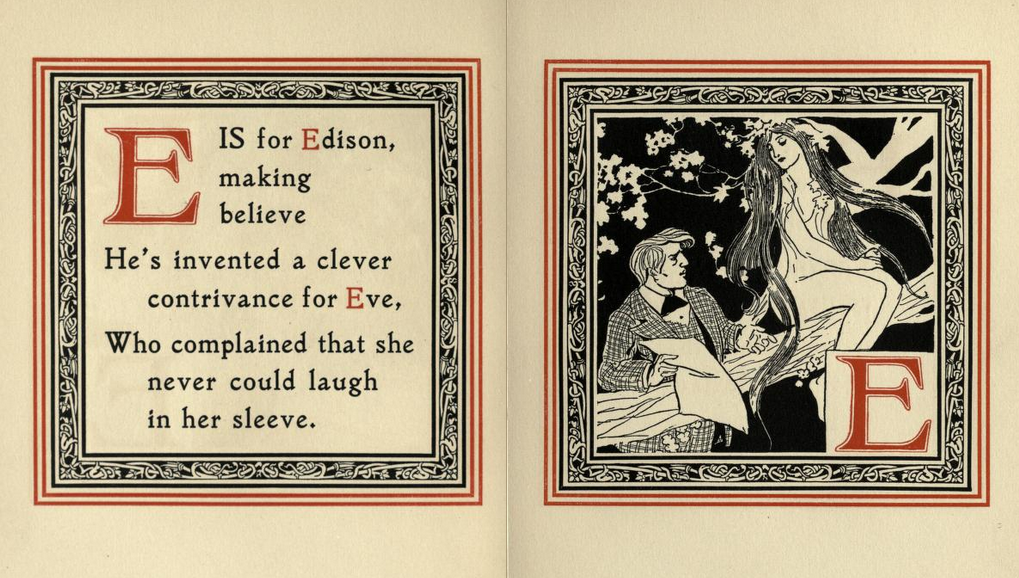Test Your Victorian Celebrity IQ
The Vault is Slate's history blog. Like us on Facebook, follow us on Twitter @slatevault, and find us on Tumblr. Find out more about what this space is all about here.
This pretty Alphabet of Celebrities was written and illustrated by Oliver Herford, an American humorist who was once well-known enough to be quoted by Woodrow Wilson in his speeches, and is now almost completely forgotten. It was printed in Boston in 1899.
Herford, a childhood emigree from England, had the nickname “The American Oscar Wilde.” Like Wilde, he was known for bon mots: “My wife has a whim of iron”; “Manuscript: something submitted in haste and returned at leisure”; “A woman's mind is cleaner than a man’s—she changes it oftener.”
Herford illustrated and wrote wry little books, parodies of existing formats laced with social commentary. These included the still-pretty-hilarious Little Book of Bores (1906); The Fairy Godmother-in-Law (1905); and The Mythological Zoo (1912).
This book arranges “celebrities” from across the centuries in little tableaus, thrown together by the happenstance of sharing initials. It’s as though they’re all at a big party, having awkward social interactions—the observance of which was one of Herford’s specialties.
Many of the figures, both Victorian and historical, who were once enough a part of the cultural vocabulary to form the basis for Herford’s satire are no longer household names. A parlor game for your holiday: Click through the book and see how many of the celebrities used in Herford’s whimsical scenarios you recognize. I’ve made an answer key, which you can find below the book, of my own best guesses for the more obscure players.
Thanks to the Public Domain Review, where I first saw this book.
A: Albert Edward, Victoria’s heir; later Edward VII, King of England. King Arthur. Alcibiades, Athenian statesman and general. Aphrodite, the Greek goddess of love.
B: Sarah Bernhardt, 19th-century French actress. Otto Van Bismarck, first chancellor of a united Germany. Barabbas, prisoner pardoned by Pontius Pilate in the New Testament. Sir Francis Bacon, English philosopher and early scientist.
C: Christopher Columbus. Confucius. Thomas Carlyle, Scottish philosopher, essayist, and historian. Cleopatra. Cain, of “Cain and Abel.”
D: Diogenes, Greek philosopher of cynicism. Charles Darwin. Dante Alighieri.
E: Thomas Edison. Eve, of “Adam and.”
F: Benjamin Franklin. Francois Fenelon, 17th-century French Catholic bishop and author. Frederick William Faber, 19th-century English theologian and convert to Catholicism. George Fox, founding Quaker.
G: Lady Godiva, who supposedly rode naked in public to protest her husband’s taxation policies. Charles Gounod, 19th-century French composer. Oliver Goldsmith, 18th-century English novelist and playwright.
H: Georg Friedrich Handel. William Dean Howells, 19th-century American author and critic. Homer, Greek author of the Iliad and the Odyssey.
I: Henrik Ibsen, 19th-century Norwegian playwright. Sir Henry Irving, 19th-century English actor and theatre manager. Ingersoll: Perhaps 19th-century American lawyer and secularist Robert Ingersoll?
J: Samuel Johnson, English critic, poet, and essayist. The biblical Jonah.
K: Kaiser Wilhelm II, last German Emperor and King of Prussia. Nineteenth-century British writers Rudyard Kipling and John Keats.
L: Jean de La Fontaine, 17th-century French poet and author of fables. Martin Luther. Nineteenth-century Hungarian composer and pianist Franz Liszt. Loie Fuller, 19th-century American dancer.
M: Macduff, from Macbeth. John Milton. Sixteenth-century French essayist Michel de Montaigne. Manon Lescaut, lead character of the nineteenth-century novel adapted into an opera by Jules Massenet and Giacomo Puccini.
N: Napoleon Bonaparte. The Roman emperor Nero. The Greek mythological figure Narcissus. Max Nordau, 19th-century Hungarian founder of Zionism.
O: Oliver Cromwell, 17th-century "Lord Protector" of the Commonwealth of England. Omar Khayyam, 11th-century Persian poet and astronomer.
P: Saint Peter, the gatekeeper of Heaven. Thomas Paine, author of Common Sense. Ignacy Jan Paderewski, Polish pianist. Edgar Allan Poe.
Q: Queen Victoria.
R: Anton Rubenstein, 19th-century Russian composer and pianist. Rollo, the fictional protagonist of a popular series of 19th-century children’s books by American minister Jacob Abbott. The painter Rembrandt van Rijn.
S: Algnernon Charles Swinburne, 19th-century English poet and critic. Sappho, Greek lyric poet. Victorien Sardou, 19th-century French playwright. Socrates.
T: Charles-Maurice de Talleyrand, French statesman and diplomat during the French Revolution and the time of Napoleon. Mark Twain.
U: Undine, water spirit in an 1811 German romantic novella. Ulysses, or Odysseus, main character of Homer’s Odyssey. King Umberto I of Italy.
V: Queen Victoria.
W: Richard Wagner, 19th-century German composer. George Washington. Charles Wesley, 18th-century hymnwriter and brother of John, the founder of Methodism. 18th-century hymnwriter and theologian Isaac Watts, who collaborated with Wesley.
X: Xantippe, Athenian and possibly wife of Socrates. Xerxes the Great, Persian emperor in the fifth century BCE.
Y: Brigham Young, second president of the Church of Jesus Christ of Latter-Day Saints. Yum-Yum, an ingenue character in Gilbert and Sullivan's "Mikado." Yvette, a courtesan and heroine of an 1884 short story by Guy de Maupassant—or, perhaps, Yvette Guilbert, Parisian singer and actress.
Z: Nineteenth-century French author Emile Zola. Zenobia, third-century queen of the Palmyrene Empire. Zuleika, Biblical figure and wife of Potiphar.
Update, Dec. 27: Since this post went up, helpful readers have written to confirm and correct some of my guesses. Kaiser Wilhelm must be Kaiser Wilhelm II, not I (the mustaches give him away). The "Wesley" referred to is probably Charles, brother of John, who collaborated on hymns with Isaac Watts. And I added identifications for Yum Yum and Yvette, who somehow escaped my notice.
Correction, Dec. 27: This post originally misspelled Edgar Allan Poe's middle name.

